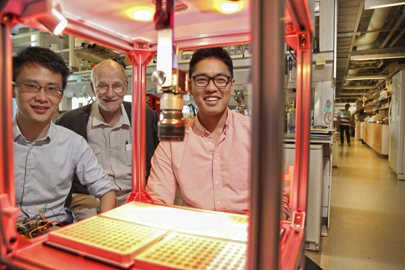Scientific innovation for positive impact: SPROUT awards announced
Innovation center bestows $100,000 to advance research

From left: Fang Guo, a postdoctoral fellow in the Rosbash lab and co-inventor of the FlyBox, Professor Michael Rosbash and Jae Jung ’15, whose project was funded among those of other SPROUT award winners.
On a tense Tuesday afternoon, Brandeis University research teams made up of students, faculty and staff faced a make-it-or-break-it moment: It was time for the final SPROUT pitches, and while the funding pool was larger than ever, so was the number of teams vying for the coveted seed money.
Now in its sixth year, SPROUT doubled its available grant pool to $100,000 in an effort administered by the university’s Office of Technology Licensing and sponsored by the Office of the Provost and Hassenfeld Family Innovation Center. The innovation center wanted to support more teams seeking funds for bench research and to award larger sums to proposals demonstrating the potential to expand their reach.
Projects ranged from inhibiting ovarian cancer cells to simplifying identification of mosquito and tick-borne diseases to 3-D printing of experimental pharmaceuticals. After submitting preliminary proposals in March, teams prepared final presentations for a panel of industry experts, investors and entrepreneurs. Participants attended workshops, reorganized slide decks and worked alongside mentors – hoping to ultimately claim a portion of the $100,000.
Eric Furfine PhD ’88, chair of the judging panel as well as chief scientific officer and acting chief executive officer of ImmuneXcite, has seen a marked improvement in proposals over the years. “[SPROUT] has grown in quality of work, the level of relevant innovation has increased and the caliber of presentations has tremendously improved,” he said. “Also, presenters were much more receptive to the judges’ counsel. The judges are invested in preparing teams to make a real impact on the world.”
The eight teams to ultimately receive funding were:
- Professor Nelson Lau and his team look to improve upon current gene therapies to study disease, among other implications, with their project titled CLASPER. Their work aims to overcome significant barriers in current DNA repair technologies, a major goal in genome editing.
- Professor Maria-Eirini Pandelia’s team, led by undergraduate Ben Pomerantz, focuses on developing an inexpensive and large-scale production of a hybrid cyclic dinucleotide, which will facilitate explorative studies surrounding its role in cellular function. Hybrid cyclic dinucleotides may be involved with the cellular communication that potentially influences immune responses.
- A team led by graduate student Jie Li and advised by Professor Bing Xu is working to eradicate drug-resistant ovarian cancer via a hydrogel that selectively targets and kills ovarian cancer cells, leaving healthy cells untouched. Xu hopes the hydrogel will lead to a more effective ovarian cancer drug, among other research discoveries.
- Yasuyuki Shima, a postdoctoral fellow in Professor Sacha Nelson’s lab, is developing a platform to identify and separate specific cell types to aid in future research. The goal is to create a novel research tool for gene therapy and stem cell-derived cellular therapy studies.
- Professor Lawrence Wangh and his team received funding to develop several diagnostic kits as an easier way to determine if ticks and mosquitoes are infected with a variety of pathogens. Their work is especially relevant considering the rising concern surrounding the Zika and West Nile viruses and Lyme disease.
- A group organized by Hyung Jae Jung of Professor Michael Rosbash’s lab is developing a FlyBox prototype, a less expensive and more accurate research tool for monitoring fruit fly behavior than current technology. Fruit flies are very common models for studying sleep and brain functions, as theirs have many similarities to those of humans.
- Professor Li Deng and graduate student Xiao Zhou received SPROUT funding to develop a new organic catalyst, making the synthesis of chiral trifluoromethylated amines, a building block in many pharmaceuticals, easier and more efficient. By using better organic catalysts, the high cost and negative environmental impacts of producing those pharmaceuticals can be reduced.
- The final SPROUT team aims to reduce the incidence of cancer and neurodegeneration associated with aging. The award will permit Professor Lizbeth Hedstrom and her team to further examine their discovery of a small molecule and determine its feasibility as a new therapy.
SPROUT panel judges included Rebecca Menapace, associate provost and executive director of the innovation center and Office of Technology Licensing at Brandeis; Eric Furfine, PhD, chief scientific officer and acting chief executive officer at ImmuneXcite; Martin Freed, MD, biopharmaceutical consultant and former chief marketing officer of Civitas; Yolanda Nesbeth, PhD, director at Celdara Medical; Vipin Suri, PhD ’01, vice president of research at Obsidian Therapeutics; and Susan Windham-Bannister, PhD ’77, managing partner at Biomedical Innovation Advisors, LLC.
Categories: Business, Science and Technology





